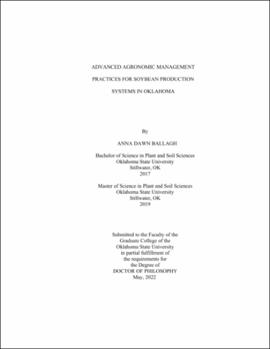| dc.contributor.advisor | Lofton, Josh | |
| dc.contributor.author | Ballagh, Anna Dawn | |
| dc.date.accessioned | 2023-03-31T19:14:54Z | |
| dc.date.available | 2023-03-31T19:14:54Z | |
| dc.date.issued | 2022-05 | |
| dc.identifier.uri | https://hdl.handle.net/11244/337171 | |
| dc.description.abstract | Advanced agronomic management strategies for soybean (Glycine max) systems are gaining interest throughout the soybean growing regions of Oklahoma. With current increases in input prices and the emphasis on agricultural sustainability, careful considerations of existing approaches are needed to both maximize profit and ensure lasting viability of production systems. In response to this need, two studies were developed and conducted in Bixby and Perkins, Oklahoma throughout 2019, 2020, and 2021. The first study aimed to determine the effects of fallow season cover crops on overall soybean production, fallow season and in-season weed management, and soil health indicators within the system. Treatments included 4 fall-planted cover crops, 2 spring-planted cover crops, and a fallow treatment. Results of this study showed that the greatest and most consistent effect of cover crops on a soybean rotation system was improved weed management during the fallow season. Cover crops planted in the fall consistently produced greater biomass than those planted in the spring. The higher cover crop biomass led to reductions in weed biomass present at cover crop termination when compared to both the fallow treatment and the spring planted cover crops which could potentially lead to fewer needed herbicide applications. Inconsistent and non-significant results were generally observed across yield and soil health data suggesting that 3 years of fallow season cover crops would not provide benefits in those areas. The objective of the second study was to determine the impacts of a late season insecticide application, a desiccation application, and delayed harvest timings on soybean yield and seed quality. The results of this trial showed that harvest delays resulted in significant yield loss due to significant pre-harvest shatter. It was also found that an additional late season insecticide application generally resulted in higher yields than a mid-season application alone. The desiccation treatment had little effect on overall soybean yield. Prioritizing and ensuring a timely soybean harvest is vital to maintaining yield. | |
| dc.format | application/pdf | |
| dc.language | en_US | |
| dc.rights | Copyright is held by the author who has granted the Oklahoma State University Library the non-exclusive right to share this material in its institutional repository. Contact Digital Library Services at lib-dls@okstate.edu or 405-744-9161 for the permission policy on the use, reproduction or distribution of this material. | |
| dc.title | Advanced agronomic management practices for soybean production systems in Oklahoma | |
| dc.contributor.committeeMember | Arnall, Brian | |
| dc.contributor.committeeMember | Fultz, Lisa | |
| dc.contributor.committeeMember | Royer, Tom | |
| osu.filename | Ballagh_okstate_0664D_17656.pdf | |
| osu.accesstype | Open Access | |
| dc.type.genre | Dissertation | |
| dc.type.material | Text | |
| dc.subject.keywords | cover crop | |
| dc.subject.keywords | late season | |
| dc.subject.keywords | soybean | |
| thesis.degree.discipline | Crop Science | |
| thesis.degree.grantor | Oklahoma State University | |
